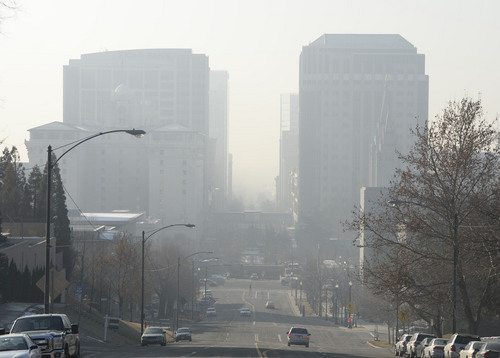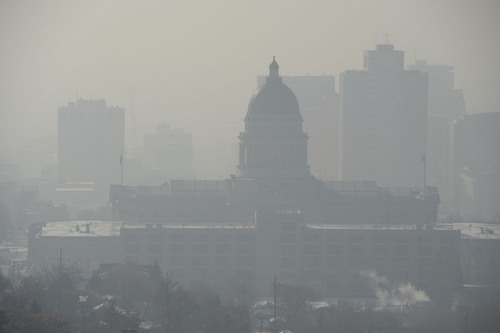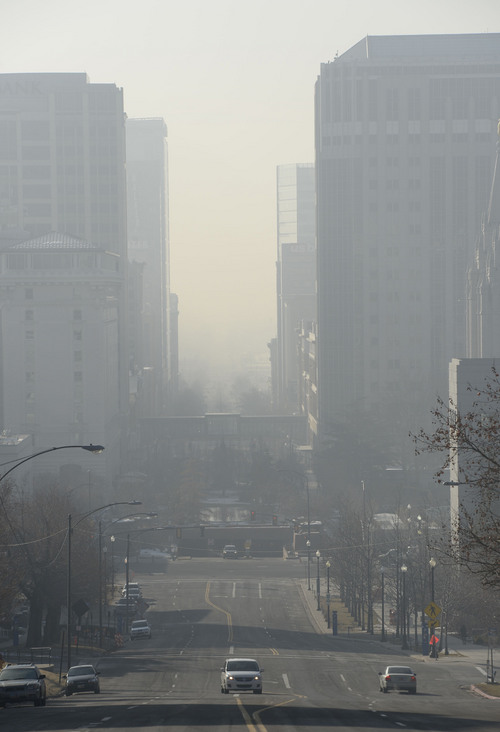This is an archived article that was published on sltrib.com in 2014, and information in the article may be outdated. It is provided only for personal research purposes and may not be reprinted.
Salt Lake City was singled out for making strides to reduce air pollution in this year's version of the American Lung Association's annual "State of the Air" report.
But the report is based on air monitoring data dating back to 2010-2012, and it doesn't account for the record-level pollution spikes of the winter of 2013 — illustrating the difficulty of gauging the success of regulatory fixes for a problem that's seasonal and weather-dependent.
"It's a good guideline to show where we stand compared the rest of the country, but this year we need to temper our excitement. … We know we'll be back up on the [most polluted cities] list next year," said Bryce Bird, director of the Utah Division of Air Quality.
The Salt Lake City, Provo and Orem area is still 8th worst in the nation for its short-term pollution spikes, for which it receives an "F" grade from the Lung Association. That corridor was 6th worst the year prior for its episodes of microscopic soot pollution, or PM2.5.
Two other cities stand out in this year's report — Logan is 11th worst for short-term particulate spikes and St. George is 5th cleanest for year-round particle pollution.
The nation overall showed a reduction in particulate pollution, which the Lung Association credits to diesel fleets and power plants.
But ozone (smog), a respiratory irritant recently found to cause cancer, remains a growing problem that climate change is bound to make worse, the report says.
"We know that warmer temperatures increase risk for ozone pollution, so climate change sets the stage for tougher challenges to protect human health. We must meet these challenges head on to protect the health of millions of Americans living with asthma and chronic obstructive pulmonary disease," said Harold Wimmer, the association's national president and CEO, in a press release.
"All of us — everyone in every family — have the right to healthy air," he said.
Utah's ozone problem is not confined to Uintah County, but the region gets an "F" for its unusual winter ozone problem linked to oil and gas development.
The report shows there were nine days of "very unhealthy" ozone pollution in the area, 20 "unhealthy days" and 37 days unhealthy for the young, old and people with heart and lung problems.
Utah lawmakers this year pitched an unprecedented number of clean air bills, but only a third passed and those were not the real "game changers," according to clean air advocates.
Still, Glenn Lanham, executive director of the Lung Association's Utah chapter, believes "anything that gets passed and that increases awareness is a plus."
Nearly one-third of Utah's 2.9 million residents are estimated by the association to be vulnerable to pollution.
kstewart@sltrib.com Twitter: @KStewart4Trib —
Most-polluted cities
Short-term particle pollution:
1 Fresno-Madera, Calif.
2 Visalia-Porterville-Hanford, Calif.
3 Bakersfield, Calif.
4 Los Angeles-Long Beach, Calif.
5 Modesto-Merced, Calif.
6 Pittsburgh-New Castle-Weirton,
Pa.-Ohio-W.Va.
7 Fairbanks, Alaska
8 Salt Lake City-Provo-Orem, Utah
9 El Paso-Las Cruces, Texas-N.M.
10 San Jose-San Francisco-Oakland,
Calif.
Source: American Lung Association "State of the Air 2014" report.







